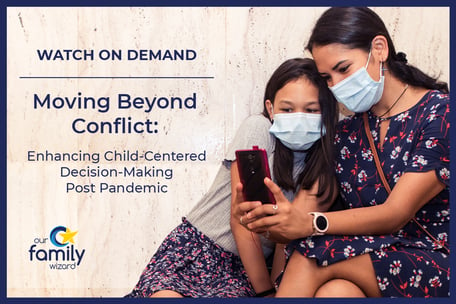Throughout the pandemic, co-parents have had to make several tough decisions that impact their children, such as whether or not to have them vaccinated or attend in-person classes at school. As family law professionals help parents make decisions like these, many will choose to take a child-centered approach to surface the best possible outcome for each child involved.
In July 2021, we brought together a group of family law experts to provide insights on child-centered decision-making processes and share advice on how to protect the needs and rights of children when making big decisions, both related and unrelated to the pandemic.
Here, we've recapped five key takeaways from this virtual panel discussion.
1. Children have been off the radar
"Children have been off the radar for the last year and a half," says Dr. Michael Saini, Associate Professor at the University of Toronto. "They don't have the typical ways that they are visible in their communities, in their schools, in their social activities, and so on."
The implementation of distancing has left children and youth facing more problems with emotional burnout, anxiety, and stress than they may have ever encountered before. Unfortunately, Dr. Saini suggests that these issues may not subside anytime too soon.
"The research is suggesting that it's not just right now, but we should be ready for an increase in children's mental health [problems] in the next six months, in the next year, in the next two years, and so on as begin to go back to whatever that 'new normal' is going to look like," says Dr. Saini
Dr. Saini believes that adults must keep a child-centered perspective and consider the rights and vulnerability of children to keep their needs met as we continue to face challenges brought on by the pandemic.
2. "Children are people now, not people in the making."
Dr. Saini explains that many parents struggle to reach agreements on crucial topics that will continue to significantly impact their children's lives even after we hit a post-pandemic stage. Among these topics are parenting plans, vaccinations, access to peer connections, and even their nutrition.
How much should children be involved in making choices like these? Dr. Saini advocates for giving due weight to their voices and opinions in these decision-making processes.
Citing the basic premise of the United Nations Convention on the Rights of the Child (UNCRC)—children are people now, not people in the making—Dr. Saini explains, "Although there are vulnerabilities that need to be considered, children and youth have a right to be engaged, and they have a right to be active agents in their own lives and be treated seriously."
3. Child-centered decision-making in five steps
How do you apply a child-centered decision-making process to family law? Dr. Saini describes five steps for doing so effectively in the panel discussion. One of those five steps is to consider what the child has to say about a matter before making a final decision.
Former Los Angeles County Superior Court Judge, Hon. Robert A. Schnider, says that this five-step process is one that everyone can support: "I believe that we can all agree that children ought to be a central focus—and the child-centeredness of the parent ought to be a central focus—of what we're looking at when we make decisions and when we counsel our clients."
He continues, "For therapists and lawyers, it's great to promote this with parents that you are involved [with]. For judges, it would be great to make it clear that child-centered decision-making will be an important factor in [your] decision-making. When you make it normative, you have people understand that that's what you will be looking for."
4. Three C's of co-parenting
Another panelist, attorney Jeralyn Lawrence of New Jersey, believes that it is very powerful for parents to understand the UNCRC's message of how children are people now, not in the making. She describes how, in her practice, she walks parents through what they should consider as they come up with decisions that would impact their child.
"What I say to my clients all the time is that when you're making a decision as it pertains to your children, please envision us standing in front of a court, a stranger in a black robe who is going to be ruling on your decision," she says.
Lawrence lets her clients know that you will generally come to the right decision so long as you follow the three C's of co-parenting: compromise, communicate, cooperate. Lawrence covers these three C's in greater depth during the panel discussion.
5. Keep your toolbelt robust
In her work as a Parenting Coordinator in Maryland, attorney Laura Burrows believes that having a wide variety of tools in your toolbelt is vital—and that you shouldn't use every tool for every set of parents.
For example, Burrows finds that some parents genuinely need a bit of education. Providing articles, research, or even YouTube videos can be powerful tools that help parents understand why it's essential to redirect their focus onto the child. In particular, she references a powerful TED Talk on the impact of adverse childhood experiences as a resource she shares frequently.
Burrows finds that many parents are unaware that their own childhood experiences may be impacting their decision-making currently. She describes how if she's hit an impasse with one parent, she will ask them questions to learn more about what might be going on below the surface to get to an "A-ha!" moment where she better understands what's driving their decisions.
"Checking in with parents means that you're telling them that they're important, too," she says. "As practitioners, we're modeling for the parents how to work with their children. If we can be better attuned to parents, they can be more attuned to their own children in return."
